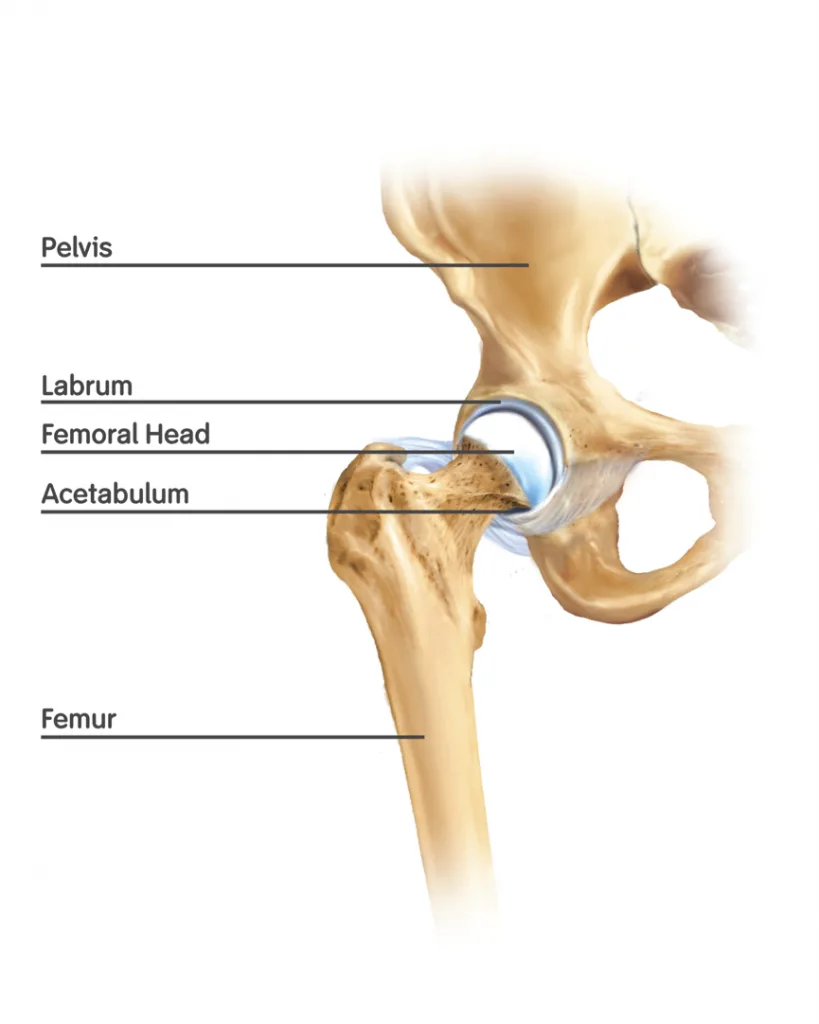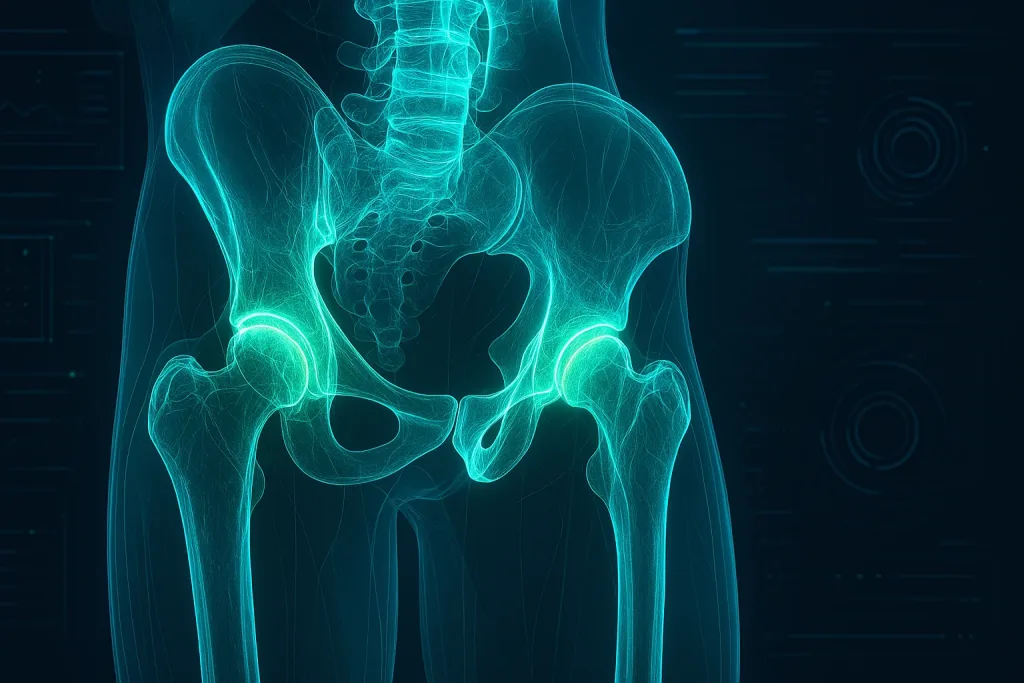Hip pain after running is a common complaint, often causing frustration and interrupting training schedules. The hip is a complex ball-and-socket joint, surrounded by powerful muscles, tendons, and ligaments, all working together to propel you forward. This complexity, however, also makes it susceptible to various strains and stresses, especially under the repetitive impact of running.

What Causes Hip Pain After Running?
Pinpointing the exact reason for your post-run hip soreness is key to effective treatment. Several structures around the hip can become irritated or injured from the demands of running.
1. One frequent offender is simple muscle strain.
Overworking or improperly warming up the muscles around the hip, like the hip flexors at the front, the glutes in the buttocks, or even the hamstrings at the back of the thigh, can lead to microscopic tears. This typically results in localised pain, tenderness when you press on the area, and sometimes a feeling of weakness during movement. Think about that sudden increase in hill sprints or forgetting your usual pre-run routine – these can sometimes be enough to cause a strain.
2. Another common issue, particularly causing pain on the outside of the hip, is Iliotibial (IT) Band Syndrome.
The IT band is a long, thick band of connective tissue running from your hip down the outer thigh to just below your knee. If it becomes tight, often due to underlying weakness in the gluteal muscles that help stabilise the hip, it can rub against the bony prominence on the outside of your hip (the greater trochanter) or knee, causing friction and inflammation. This often feels like a sharp or burning pain that might start mid-run and worsen as you continue. Similarly, Hip Bursitis, specifically trochanteric bursitis, involves inflammation of the bursa – a small, fluid-filled sac that cushions the bone – located over that same bony point on the outer hip. This can feel very similar to IT band syndrome, presenting as sharp or aching pain, often tender to touch and aggravated by lying on the affected side or climbing stairs.
3. More serious, though less common, causes include Stress Fractures.
These are tiny cracks in the bone, often the femoral neck (the top part of the thigh bone connecting to the hip socket), resulting from repetitive stress exceeding the bone’s ability to repair itself. This usually causes a deep, aching pain within the hip or groin that worsens significantly with weight-bearing activity and might even persist at rest. A stress fracture requires prompt medical evaluation and usually means a significant break from running.
4. Hip Impingement, or Femoroacetabular Impingement (FAI), is a condition where structural abnormalities in the hip joint cause the ball (femoral head) and socket (acetabulum) to rub against each other abnormally during movement.
Runners with FAI often experience a deep ache or sharp pain in the groin or front of the hip, particularly during or after runs, or with movements involving deep hip flexion like squatting.
5. Finally, underlying conditions like osteoarthritis or labral tears (damage to the cartilage rimming the hip socket) can also manifest as hip pain exacerbated by running, especially in older individuals or those with a history of hip problems. Identifying the specific cause often requires a careful assessment by a healthcare professional.
How Can I Prevent Hip Pain When Running?
Preventing hip pain is far better than treating it! Thankfully, several proactive strategies can significantly reduce your risk. It all starts before you even take your first stride, with a proper warm-up.
Forget those old-school static stretches where you hold a position for 30 seconds; before running, focus on dynamic movements. Think leg swings (forward-back and side-to-side), hip circles, walking lunges, and torso twists. These movements actively warm up the muscles and increase blood flow to the hip area, preparing the joint for the demands of running much more effectively than passive stretching. Five to ten minutes of dynamic stretching can make a world of difference.
Your running form plays a massive part in how forces are distributed through your body. Poor mechanics can overload the hips. Pay attention to things like your cadence (aiming for around 170-180 steps per minute often helps reduce impact), avoiding overstriding (landing with your foot too far in front of your body), and maintaining good posture (running tall, engaging your core).
If you consistently struggle with hip pain or other running injuries, investing in a professional running analysis can be invaluable. Experts can identify subtle flaws in your gait and provide specific cues and exercises to correct them. Alongside good form, strength training is non-negotiable for injury prevention. Weak core muscles, glutes (especially the gluteus medius, which stabilises the hip), and hip abductors force other structures to compensate, often leading to pain. Incorporate exercises like bridges, clamshells, side planks, single-leg deadlifts, and bird-dogs into your routine two to three times a week. Strong supporting muscles act like scaffolding for your hips.
Equally important is managing your training load. The gradual increase principle is fundamental – avoid sudden jumps in weekly mileage, run duration, or intensity (like adding speed work or hills). A common guideline is the “10% rule,” suggesting you increase your total weekly mileage by no more than 10% from the previous week. Listen intently to your body; don’t push through developing pain. Your choice of footwear also matters. Ensure your running shoes are appropriate for your foot type (neutral, stability, or motion control) and running style, and replace them regularly – typically every 300-500 miles, as the cushioning degrades over time.
Consider cross-training with low-impact activities like swimming, cycling, or using an elliptical machine. This allows you to maintain cardiovascular fitness while giving your hips a break from the repetitive pounding of running. Finally, don’t neglect the cool-down. After your run, perform gentle static stretches, holding each for 20-30 seconds, focusing on the hip flexors, glutes, hamstrings, and quadriceps. Using a foam roller on your glutes, hamstrings, and IT band can also help release muscle tightness and improve flexibility.
When Should I See a Professional About Hip Pain?
While some minor hip soreness might resolve with rest and self-care, certain signs indicate it’s time to seek professional help. Don’t ignore pain that persists. If your hip pain doesn’t improve after a week or two of reduced activity, ice, and gentle stretching, it’s wise to get it checked out. Persistent pain often signals an underlying issue that needs specific treatment beyond simple rest. The severity of the pain is also a key indicator. If the pain is severe, making it difficult to walk normally, climb stairs, or perform daily activities, a professional assessment is necessary. Pain that prevents you from bearing weight on the affected leg warrants immediate attention.
Pay close attention to when the pain occurs. While post-run soreness is common, pain at rest or pain that wakes you up at night can be red flags for more serious conditions like a stress fracture or significant inflammation. Any obvious signs of injury, such as visible swelling around the hip, bruising without a clear cause (like a fall), or a sudden inability to move the hip properly, should prompt a visit to a healthcare provider. Similarly, mechanical symptoms like clicking, popping, catching, or a feeling of the hip locking or giving way suggest a potential structural problem within the joint itself, such as a labral tear or impingement. If you experience numbness, tingling, or radiating pain down your leg, it could indicate nerve involvement, possibly originating from the hip area or the lower back, which also requires investigation.
In these situations, consulting professionals such as those at clinics like Life Fit Wellness is recommended. A qualified physiotherapist can perform a thorough assessment, including specific tests, to diagnose the root cause of your hip pain. They can differentiate between muscle strains, bursitis, IT band issues, impingement, and other potential causes. Based on the diagnosis, they can develop a personalised treatment plan which might include manual therapy, targeted exercises, advice on activity modification, and potentially referrals for further investigation like imaging or consultation with specialist clinics if needed. Ignoring persistent or severe symptoms can lead to chronic problems and prolonged time away from running.
Conclusion
Experiencing hip pain after running can certainly be disheartening, putting a damper on your fitness goals and enjoyment. However, understanding that it’s often linked to identifiable causes like muscle imbalances, overuse, or biomechanical issues is the first step towards recovery. From muscle strains and IT band syndrome to bursitis or even stress fractures, pinpointing the specific reason for your discomfort is essential for effective management. Remember the power of prevention! Implementing strategies like consistent dynamic warm-ups, focusing on good running form, diligently performing hip and core strengthening exercises, increasing training load gradually, and choosing appropriate footwear can significantly reduce your chances of developing hip pain in the first place. Don’t underestimate the value of listening to your body and incorporating rest and recovery, including cool-downs and stretching, into your routine.
While self-care measures are often effective for minor aches, don’t hesitate to seek professional guidance if your pain is persistent, severe, occurs at rest, or is accompanied by mechanical symptoms or signs of significant injury. A physiotherapist can provide an accurate diagnosis and a tailored rehabilitation program to address the underlying cause, helping you return to activity safely and effectively. With the right knowledge and approach, most cases of hip pain after running can be successfully managed, allowing you to get back to pounding the pavement pain-free. Keep moving, but move wisely!
Frequently Asked Questions (FAQs)
Q1: Can running shoes cause hip pain?
A: Yes, improper or worn-out running shoes can contribute to hip pain. Shoes that don’t provide the right support for your foot type or gait can alter your biomechanics, potentially leading to increased stress on the hips. Ensure your shoes are suitable for your needs and replace them regularly.
Q2: Is it okay to run through mild hip pain?
A: It’s generally not advisable to push through pain. Mild discomfort might occasionally occur, but persistent or worsening pain during or after a run is your body’s signal that something is wrong. Ignoring it can lead to a more significant injury. Rest, assess the potential cause, and consider modifying your activity.
Q3: How long does runner’s hip pain typically last?
A: The duration depends heavily on the cause and severity of the injury, as well as the treatment approach. Minor muscle strains might resolve in a few days to a couple of weeks with proper care. More complex issues like bursitis, IT band syndrome, or stress fractures can take several weeks or even months to heal completely.
Q4: Are there specific stretches that are best for hip pain after running?
A: Stretches focusing on the hip flexors (like a kneeling lunge stretch), glutes (like a figure-four stretch or pigeon pose), piriformis, hamstrings, and IT band (though direct IT band stretching is debated, foam rolling is often preferred) can be beneficial after running or as part of a flexibility routine. Remember dynamic movements for warm-ups and static holds for cool-downs.
Q5: Can dehydration cause hip pain when running?
A: While dehydration doesn’t directly cause structural hip pain like bursitis, it can lead to muscle cramps and fatigue, which might indirectly contribute to poor form and subsequent strain or discomfort in various areas, potentially including the hips. Staying well-hydrated is important for overall running performance and injury prevention.












